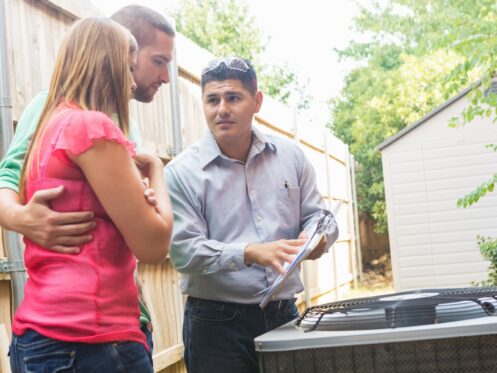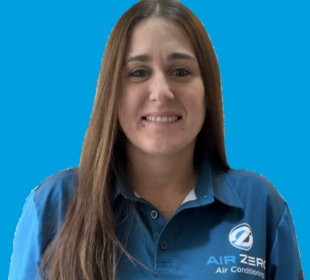Your air conditioner or heat pump does a lot of work to keep your home comfortable, but not all systems run with the same level of efficiency. That’s where SEER ratings come in. SEER, or Seasonal Energy Efficiency Ratio, tells you how well a unit cools compared to the amount of energy it uses.
A higher SEER rating means your AC uses less energy, which can help lower your power bill. But the highest number isn’t always the best choice. You need a system that fits your budget, works well, and keeps your home comfortable. If you live in the vicinity of St. Petersburg, FL, our team at Air Zero can help, ensuring you get a system that keeps you comfortable without driving up energy costs.
What SEER Ratings Measure
SEER is a way to figure out how well your air conditioner cools your home. Think of it like miles per gallon in a car—the higher the number, the more cooling you get for each unit of electricity used.
To get the number, divide the amount of cooling a system does over a normal cooling season by the amount of power it needs. A SEER rating isn’t a fixed efficiency number, though; it’s based on an average, meaning real-world conditions like temperature extremes and humidity levels can affect how well your system actually performs.
That’s why a unit with a high SEER rating can still struggle if it’s not the right size for your home or if your ductwork isn’t in good shape.
Do Higher SEER Ratings Always Mean Bigger Savings?
It’s easy to assume that installing an air conditioner with a higher SEER rating will automatically cut your cooling costs significantly, but that’s not always the case. While a more efficient unit can help reduce electricity use, your actual savings depend on factors like how often you run your AC, how well your home is insulated, and the condition of your existing HVAC system.
If your current system has a SEER rating of 10, switching to a SEER 16 unit can lower your cooling costs a lot. But if you already have a unit with a SEER of 14 and are considering upgrading to a SEER 18 model, the difference in savings may not be as dramatic, especially if your home isn’t properly sealed or insulated.
Another factor to consider is the up-front cost. Higher-SEER units tend to be more expensive, so you’ll want to calculate whether the long-term energy savings justify the initial investment. In some cases, the savings will be noticeable within the first few years. In others, it might take longer to see a return on your investment.
How SEER Affects Home Comfort
SEER ratings aren’t just about saving money. They also play a big role in how comfortable your home feels. Many higher-SEER systems come with advanced features like variable-speed compressors and multi-stage cooling, which allow them to run at different speeds rather than simply turning on and off at full blast.
This means your home stays at a more consistent temperature without the constant swings between too hot and too cold. If you’ve ever noticed that your AC blasts cold air for a few minutes, then shuts off, only to kick back on when the house warms up again, you’ve experienced the “On/Off” cycle of a lower SEER system. High-efficiency units adjust their cooling levels gradually, so you don’t get those temperature fluctuations.
A higher-SEER unit can also help control humidity better. Systems with variable-speed fans and compressors run longer at lower speeds, which allows them to remove more moisture from the air. This can make your home feel cooler even if the thermostat setting doesn’t change.
Florida Climate Impact on Choosing a SEER Rating
Living in Florida means your air conditioner isn’t just a luxury—it’s a necessity for most of the year. With long, hot summers and humidity that never seems to quit, your AC probably runs more often than not. That’s why SEER ratings matter so much. A high-SEER system can help lower your energy bills since it uses less electricity to keep your home cool. Unlike in cooler states where ACs might only run for a few months, Florida homeowners actually get to see the savings from an efficient system sooner because it’s working nearly year-round.
Also, the ventilation in your home has a lot to do with how well your AC works. If your home has leaky windows, poor attic insulation, or gaps around doors, even the highest-rated unit won’t be able to keep up. Before upgrading to a high-SEER model, it’s worth making sure your home isn’t losing cool air. A well-sealed, well-insulated house combined with an energy-efficient AC is the best way to keep comfortable without overpaying on electricity.
Upgrading From an Older System
If you’re replacing an older air conditioner, chances are it has a much lower SEER rating than what’s available today. Units installed 15 to 20 years ago often had SEER ratings as low as 8 or 10. The minimum SEER rating allowed for new systems has increased in recent years, meaning even a basic upgrade will likely be more efficient than what you currently have.
Newer systems also come with features that improve performance and comfort. Many high-SEER units include features like two-stage or variable-speed compressors, which let them change the amount of power they put out instead of always going at full power. This keeps your system running smoothly, helps it last longer, and makes it more energy-efficient.
If you’re thinking about upgrading, you’ll also want to consider whether your home’s ductwork is in good shape. Leaky or poorly insulated ducts can waste a lot of the cool air your AC produces, making even a high-efficiency system work harder than it should. Having your ductwork inspected and sealed can help you get the most out of a new high-SEER unit.
SEER and Rebates!
In Florida, upgrading to a high-SEER air conditioning system could come with some financial perks. Many utility companies across the state offer rebates for homeowners who install energy-efficient equipment, helping to offset some of the up-front costs. Since Florida’s hot and humid climate means AC systems run almost year-round, these programs encourage homeowners to invest in models that use less electricity while keeping homes cool.
In addition to utility rebates, you might qualify for state or federal tax incentives when upgrading to a high-SEER unit. These programs help cut energy use, lower bills, and support eco-friendly cooling. Before you upgrade, check with your utility company or an HVAC expert to see what savings are available. A more efficient system not only cuts down on your energy bills but could also put some money back in your pocket up-front.
Making the Right Choice for Your Home
Choosing an air conditioner isn’t just about picking the unit with the highest SEER rating. While efficiency is important, it’s also essential to consider factors like the size of your home, how well it’s insulated, and how much cooling you actually need.
An expert in HVAC systems can help you weigh your choices and pick the best system for your house. They can also assess whether other upgrades, like better insulation, duct sealing, or a programmable thermostat, might help improve efficiency before you invest in a new unit.
We’ll Help You With Your SEER Rating
When it comes to your home’s cooling system, efficiency matters—not just for your wallet, but for your overall comfort. If you’re unsure what SEER rating is best for your home in St. Petersburg, our cooling services experts can guide you to the right system for long-term savings and reliable comfort. Contact us at Air Zero today.

